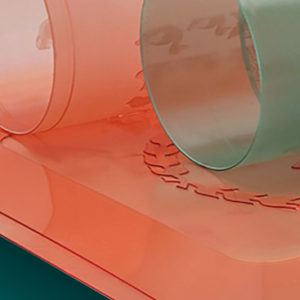Flexography
 Flexographic plates, like letterpress plates, are relief plates with image elements raised above open areas. They are elastomeric in nature in contrast with hard letterpress plates. They use rotary presses and low viscosity inks. Flexographic plates have a Shore A durometer hardness of 25-55 versus durometer readings in excess of 60 for letterpress plates. The process was originally called aniline printing because of the aniline dye inks that were first used in the process. Coarse surfaces such as corrugated board and stretchy films can economically be printed only with this process. Flexography leaped into prominence with the introduction of cellophane as a packaging material.
Flexographic plates, like letterpress plates, are relief plates with image elements raised above open areas. They are elastomeric in nature in contrast with hard letterpress plates. They use rotary presses and low viscosity inks. Flexographic plates have a Shore A durometer hardness of 25-55 versus durometer readings in excess of 60 for letterpress plates. The process was originally called aniline printing because of the aniline dye inks that were first used in the process. Coarse surfaces such as corrugated board and stretchy films can economically be printed only with this process. Flexography leaped into prominence with the introduction of cellophane as a packaging material.
Flexographic printing plates are an extension of rubber stamps. Most rubber plates are made of natural or nitrile rubber of varying hardness. First photopolymer flexo plates were made from liquid photopolymers introduced by Asahi in 1972. DuPont introduced the first solid flexo photopolymer plate under the trade name Cyrel in 1974.
Success of photopolymer plates revolutionized flexographic printing. Currently, more than 75% of flexographic plates used in the US are based on photopolymers. Types of chemistry used for photopolymers include styrenic polymers, nitrile rubber and acrylated polyurethanes.
In 2002, DuPont introduced Cyrel Fast technology to eliminate use of solvents in plate processing. Here, the plates after exposure are developed by removing the unexposed photopolymer by melting it away and absorbing it in a medium. Digital plates are now available from plate suppliers for use in computer-to-plate digital imagers. For names of producers of photopolymer flexographic plates, see Printing Plates.
Copyright © 2007-2008 Savla Associates

